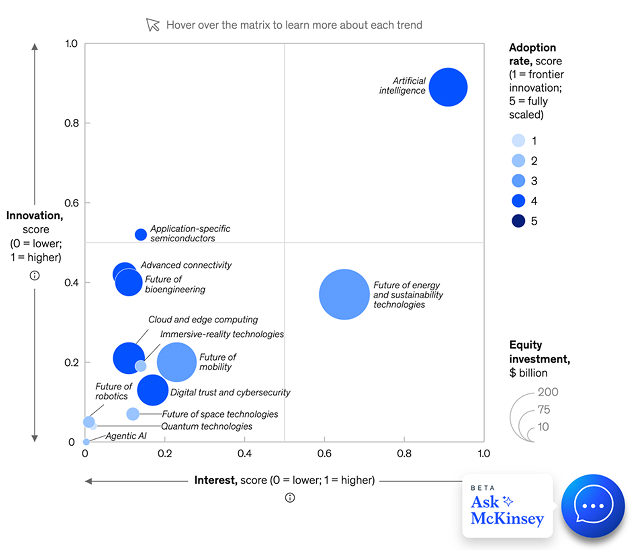Artificial intelligence (AI), automation, robotics, and advanced connectivity are transforming industries at a speed never seen before. According to McKinsey’s latest Tech Trends Outlook, more than 80% of companies are already using AI in at least one function, and over 90% plan to expand their investments.
Yet beneath this rapid progress lies a critical obstacle: a growing global talent bottleneck. The real limiter of technological progress isn’t computing power or capital — it’s people.
1. The Talent Bottleneck Behind Frontier Technologies
McKinsey identifies 13 frontier technologies that will define 2025 and beyond — from generative and agentic AI to robotics, bioengineering, space tech, quantum computing, immersive reality, and sustainable energy.

Source: McKinsey&Company, “Technology Trends Outlook 2025”.
Each of these fields shares one urgent challenge: the scarcity of skilled talent. Nearly half of AI leaders cite skills gaps as a primary barrier to adoption. Meanwhile, job postings for agentic AI rose by nearly 1000% in just one year. Roles requiring expertise in data science, cloud and edge computing, DevOps, and virtual or augmented reality are also facing intense competition.
The energy and sustainability sector underscores this issue vividly. In 2024 alone, it attracted $223 billion in equity investment, much of it in low-carbon electricity and fuels. However, realizing the potential of clean energy depends on digitization — using AI for grid optimization, automation for energy management, and data analytics for resource discovery. Without a workforce equipped with these skills, even the most promising innovations risk stalling.
2. Three Ways to Close the Tech Talent Gap
While the shortage is daunting, it’s far from insurmountable. McKinsey outlines three pragmatic approaches companies can take to bridge the gap between technology and talent.
1. Invest in Reskilling and Lifelong Learning
In tight labor markets, the fastest way to build capability is often from within. Organizations should upskill and reskill their existing workforce, focusing on both specialized technical expertise and broader digital fluency.
A standout example is Amazon’s Upskilling 2025 initiative. The company has committed $1.2 billion to provide 300,000 employees with access to free skills training through 2025. Amazon offers multiple learning pathways — from the Amazon Technical Academy, which helps non-technical employees transition into software engineering roles, to AWS Grow Our Own Talent and Mechatronics and Robotics Apprenticeships, which prepare workers for roles in advanced manufacturing and cloud computing.
Beyond any single company, the broader lesson is clear: investing in structured, ongoing education builds both workforce resilience and organizational agility. Companies that create custom learning journeys and skills hubs – and that measure and reward continuous development—will be best positioned to thrive in the next wave of technological transformation.
2. Create New Talent Models
To meet the demand for AI and data expertise, companies should rethink how and where they source talent. Many frontier technologies are not limited by geography, meaning globally distributed teams can unlock access to new skill pools.
Organizations can also leverage AI augmentation to automate routine tasks, allowing employees to focus on creative, analytical, and strategic work. Hiring practices that prioritize skills over credentials open the door to untapped potential, particularly in emerging tech regions where digital talent is accelerating rapidly.
3. Make Talent a Strategic Priority
Building advanced technologies without an equally rigorous workforce strategy is a recipe for underperformance. Organizations should synchronize hiring and training roadmaps with product and infrastructure plans, placing emphasis on roles that will deliver the greatest strategic value.
Talent planning must be a C-suite responsibility, not merely an HR concern. It should be embedded into strategic decision-making so that human capital evolves in lockstep with business direction.
IBM’s internal transformation provides a compelling illustration. Through its Enterprise Transformation and Extreme Productivity initiative, IBM applied hybrid cloud, AI, and automation technologies internally to reimagine operations — including HR and talent workflows — with the explicit goal of making the organization more productive.
Since launching the transformation in 2023, IBM claims to have generated US $4.5 billion in productivity gains and driven US $12.7 billion in free cash flow in 2024, which it then reinvested into growth via talent, innovation, and acquisitions.
This example reinforces the point: when talent becomes a top-level strategic lever, organizations can more tightly align their people with their ambition, execute more consistently, and boost both performance and employee satisfaction.
3. The Road Ahead
At Jaxel, we believe that the future of technology depends on how effectively organizations empower their people to grow with it. Innovation alone isn’t enough — the companies that will lead in AI, automation, and digital transformation are those that treat talent as a strategic asset, not an afterthought.
Our work with clients across industries shows that when businesses combine technology adoption with workforce enablement, they see faster innovation cycles, higher retention, and stronger long-term performance. From building global, distributed teams to designing tailored reskilling programs and embedding AI into workforce planning, Jaxel helps organizations turn the talent bottleneck into a competitive advantage.
The path forward is clear: technology will continue to evolve, but success will hinge on the people who drive it. Companies that invest in adaptable, interdisciplinary, and inspired teams today are building the foundations of tomorrow’s breakthroughs — and Jaxel is here to help them get there.
Contents










